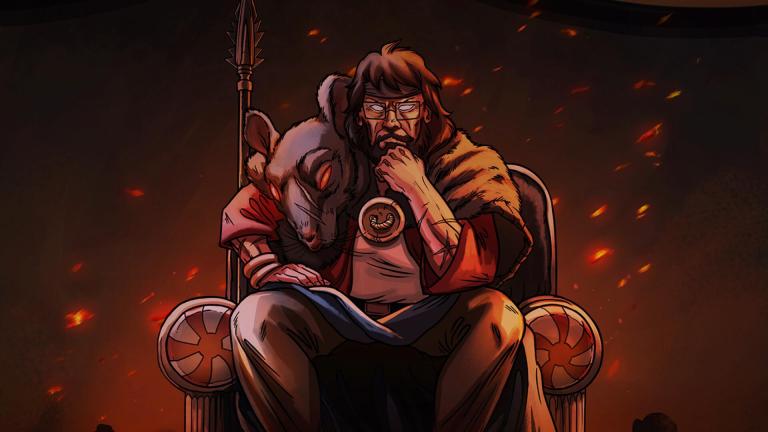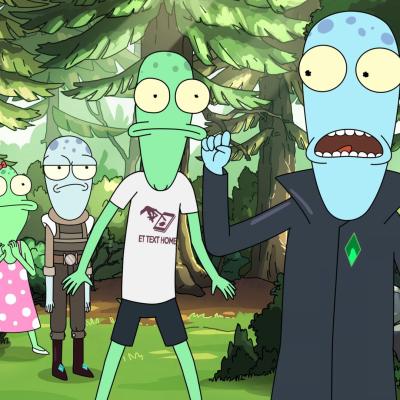Why Solar Opposites Season 2 Brought The Wall Back
Solar Opposites creators Justin Roiland and Mike McMahon speak about the origins of the Wall plotline, how it's handled in season 2, and why it’s only going to get weirder.

This interview contains SPOILERS for SOLAR OPPOSITES seasons 1 and 2.
Mike McMahan and Justin Roiland’s sci-fi animated sitcom Solar Opposites is technically about a family of aliens stuck on planet Earth learning lessons about how to love one another while they try to repair their spaceship. However, as the first season progressed, the show slowly revealed it was simultaneously telling another story.
One of the aliens, Yumyulack (Sean Giambrone), has a habit of shrinking down humans and imprisoning them in a wall-sized terrarium. In a surprising twist, we get to see that the tiny humans have actually formed their own Mad Max-ian style society in there. We learn more and more about this society until, seven episodes into the first season, Solar Opposites ditches the aliens for an entire episode set inside the Wall.
It ended up being just about everyone’s favorite thing in the show.
“We didn’t invent (the concept of) a show in a show, but I think we’re maybe the only show where the show in a show is more popular than the show,” McMahan tells Den of Geek.
When Hulu offered us the chance to speak with McMahan Justin Roiland about season two, we knew we’d better get in plenty of questions about The Wall or the Internet would come after us. Luckily, Mike and Justin love the Wall, too.
“We both love it because there’s nothing else, there’s no other project we work on, where we get to do the Wall-type stories and there’s no other show that does it like that,” says Mike.
Justin explains how, when pitching the series to other networks, he “wanted to come in there kicking the doors down and screaming about this concept and how fucking awesome it is,” but they were advised to downplay the eccentric, high-concept Wall plot.
Mike adds, “We originally thought that there was a chance that Solar would live on broadcast, would look like a big family Sunday night Animation Domination-type show. And when the show didn’t get picked up to series the first time, we then got a second hit at it with Hulu. And when we were in that pitch, there was no hiding it. We were like, ‘Also there’s gonna be a fucking ton of this Wall story.” And they were like, ‘Fine! Do whatever you want!’”
The Wall was part of the series from very early on. Justin explains:
“Mike and I developed the sort of broad strokes for the show. I actually don’t know the exact order of things, but I just know it was around the E3 that Bethesda announced Fallout Shelter [June 2014]. I was playing Fallout Shelter, I was doing a lot of VR stuff around this time [Roiland also has a video game company specializing in VR called Squanch Games], and working a lot on Solar, and just kind of brainstorming. Fallout Shelter was definitely the inspiration for the Wall ‘cuz I was just looking at it zoomed out.”
Mike interjects, “For me, it was like, Tiny Tower, was another app, an iOS game I was playing, too.”
This may seem like a surprising origin for the Wall until you Google image search these games. The similarities are immediately obvious.
As for how the Wall storyline evolved in season two, Mike says the mantra was “Never go back on the Wall. Keep the story going, but don’t just repeat. I think you see that pretty clearly. We get really weird.”
Solar Opposites uses the Wall as a vehicle for riffing on dramatic film and television tropes in a more sincere way than the crazy alien sitcom plots are capable of. The first season was an homage to dystopian cinema, culminating in a revolution. As Mike said, season two absolutely does not repeat what came before it. This time the running Wall storyline focuses on a new character, played by Sterling K. Brown, who is hunting down a serial killer in the Wall.
As in the first season, the seventh episode is a Wall-centric one that takes things in an unexpected direction by taking place almost entirely outside of the Wall, following the still alive and still tiny The Duke (Alfred Molina) and Cherie (Christina Hendricks), as they try to survive the wilds of the aliens’ backyard. To complicate things more, Cherie is pregnant with Tim (Andy Daly)’s baby. This climaxes in one of the most simultaneously thrilling, bizarre, and inspired scenes Solar Opposites has ever done, as the shrunken Cherie ends up giving birth inside a Pez dispenser as normal-sized alien Jesse (Mary Mack) ejects Pez candies into her mouth one after another, unknowingly getting ever closer to devouring Cherie and her about-to-be-born baby.
When we mention how totally weird this scene is, Mike raises his arms in triumph and shouts:
“Yes! I love that Pez dispenser birth! It’s so fucking weird!” He also points out, adding to the weirdness, is that during this sequence Jesse is singing some kind of counterargument song to TLC’s “No Scrubs.”
“She’s singing like a pro-scrubs song. Yeah, that’s a crazy sequence.”
However, Mike adds, the unique and odd blend of drama and comedy we get from the Wall needs to be tempered with the sillier antics of Solar Opposites’ lead alien characters.
“Everybody who’s yelling, like, ‘Oh, I wish this show was all the Wall,’ that’s like somebody being like, ‘I wish Twinkie was all the cream.’ Like, you wouldn’t fucking like it or else you’d be out buying cans of whipped cream and eating that.
“The Wall is all about balance. The (alien) stuff is so tied to the Wall and we know what we’re doing with that. It’s like, how much of the Wall can we get away with to make it feel like you want it all the time? And that’s part of the fun of it, too.”
We mention that it’s cool how the Wall provides a structure for the series now, serving as a C-plot underneath the other storylines, and culminating with an all-Wall seventh episode in each season.
“Wait for season three,” Mike teases, “’cuz we like to fuck with expectations!”
The first two seasons of Solar Opposites are now streaming on Hulu.
